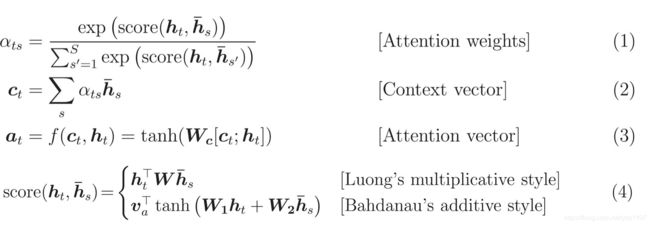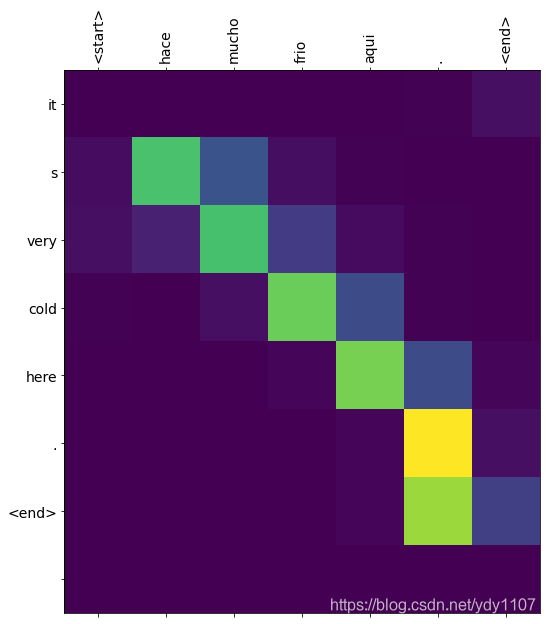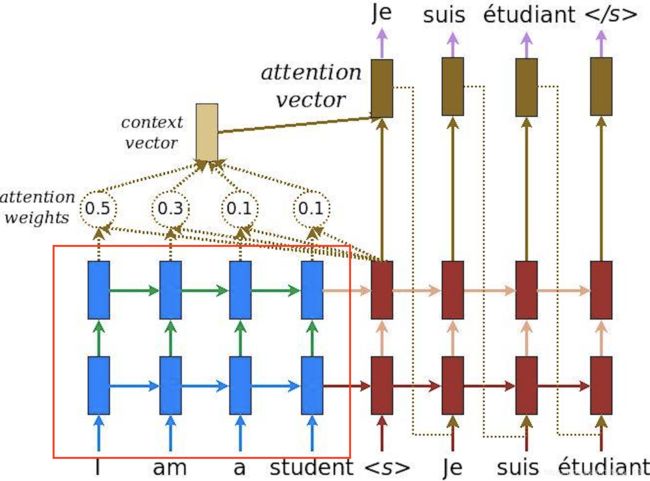基于注意力机制的Encoder-Decoder翻译器
Neural machine translation with attention 基于注意力机制的seq2seq神经网络翻译器
- 前言
- 代码解析
-
- 1. Download and prepare the dataset 数据下载和预处理
- 2. Write the encoder and decoder model 构建编码器和解码器模型
-
- Encoder model 编码器模型
- Attention layer ( BahdanauAttention) 注意力层(以Bahdanau style为例)
- Decoder mode 解码器模型
- 3. Define the optimizer and the loss function 定义优化器和损失函数
- 4. 模型训练和评估
-
- Training
- Translate
- 额外说明
-
- 1. 注意力机制
- 2. Teacher forcing
https://tensorflow.google.cn/tutorials/text/nmt_with_attention
前言
将训练一个<西班牙语/英语>的sequence to sequence模型,模型中采用了Encoder-Decoder结构、注意力机制,训练过程中还使用了Teacher forcing的方法。
本文基于个人理解对代码和相关技术作相应介绍,如有错误欢迎评论指正
代码解析
1. Download and prepare the dataset 数据下载和预处理
语言翻译训练数据包可在线下载
# Converts the unicode file to ascii
def unicode_to_ascii(s):
return ''.join(c for c in unicodedata.normalize('NFD', s)
if unicodedata.category(c) != 'Mn')
def preprocess_sentence(w):
w = unicode_to_ascii(w.lower().strip())
# creating a space between a word and the punctuation following it
# eg: "he is a boy." => "he is a boy ."
# Reference:- https://stackoverflow.com/questions/3645931/python-padding-punctuation-with-white-spaces-keeping-punctuation
w = re.sub(r"([?.!,¿])", r" \1 ", w)
w = re.sub(r'[" "]+', " ", w)
# replacing everything with space except (a-z, A-Z, ".", "?", "!", ",")
w = re.sub(r"[^a-zA-Z?.!,¿]+", " ", w)
w = w.strip()
# adding a start and an end token to the sentence
# so that the model know when to start and stop predicting.
w = ' ' + w + ' '
return w
数据的预处理包括:
- unicode 编码转ascii编码
- 全小写字母化并去除首尾空格
- 查找标点符号并在单词和标点符号之间插入空格以区分开
- 仅保留语言中可能出现的符号和字母
中文翻译可以添加 \u4e00-\u9fa5 汉字和中文标点符号 - 添加首尾标记符号 <start> 和 <end>
# 1. Remove the accents
# 2. Clean the sentences
# 3. Return word pairs in the format: [ENGLISH, SPANISH]
def create_dataset(path, num_examples):
lines = io.open(path, encoding='UTF-8').read().strip().split('\n')
#word_pairs = [[preprocess_sentence(w) for w in l.split('\t')] for l in lines[:num_examples]]
word_pairs = [[preprocess_sentence(w) for w in l.split('\t')[:2]] for l in lines[:num_examples]]
return zip(*word_pairs)
原代码没有清理掉多余信息,因此取了每行前两个元素,即构建了以 [ENGLISH,SPANISH] 为pair的[target, input]数据集。
def tokenize(lang):
lang_tokenizer = tf.keras.preprocessing.text.Tokenizer(
filters='')
lang_tokenizer.fit_on_texts(lang)
tensor = lang_tokenizer.texts_to_sequences(lang)
tensor = tf.keras.preprocessing.sequence.pad_sequences(tensor,
padding='post')
return tensor, lang_tokenizer
def load_dataset(path, num_examples=None):
# creating cleaned input, output pairs
targ_lang, inp_lang = create_dataset(path, num_examples)
input_tensor, inp_lang_tokenizer = tokenize(inp_lang)
target_tensor, targ_lang_tokenizer = tokenize(targ_lang)
return input_tensor, target_tensor, inp_lang_tokenizer, targ_lang_tokenizer
文本本身是无法交给神经网络进行训练的,因此我们需要将其映射成数字ID以便网络识别。
这里利用keras实现的Tokenizer类,流程如下:
- 初始化Tokenizer,以空格过滤来识别每个单词
- fit_on_texts(text)
功能:建立文本词表
参数texts :要用以训练的文本列表
返回值: 无 - texts_to_sequences(texts)
功能:将文本转换成对应的数字序列
参数texts :待转为序列的文本列表
返回值: 序列的列表,列表中每个序列对应于一段输入文本 - pad_sequences(sequence, padding=‘post’)
功能:将数字序列填充成相同长度
参数padding :‘pre’ 前补0,'post’后补0
参数sequence:待填充的序列
参数maxlen=None:默认填充至列表中最大长度的序列
返回值: 填充后的序列的列表
#Try experimenting with the size of that dataset
num_examples = 30000
input_tensor, target_tensor, inp_lang, targ_lang = load_dataset(path_to_file, num_examples)
input_tensor_train, input_tensor_val, target_tensor_train, target_tensor_val = train_test_split(input_tensor, target_tensor, test_size=0.2)
#Create a tf.data dataset
BUFFER_SIZE = len(input_tensor_train)
BATCH_SIZE = 64
steps_per_epoch = len(input_tensor_train)//BATCH_SIZE
embedding_dim = 256
units = 1024
vocab_inp_size = len(inp_lang.word_index)+1
vocab_tar_size = len(targ_lang.word_index)+1
dataset = tf.data.Dataset.from_tensor_slices((input_tensor_train, target_tensor_train)).shuffle(BUFFER_SIZE)
dataset = dataset.batch(BATCH_SIZE, drop_remainder=True)
- 按8:1的比例划分训练集和验证集
- 配置相关参数,生成数据集
2. Write the encoder and decoder model 构建编码器和解码器模型
实现了一个带有注意力机制的编码器-解码器模型,注意力机制详见后文。
Encoder model 编码器模型
class Encoder(tf.keras.Model):
def __init__(self, vocab_size, embedding_dim, enc_units, batch_sz):
super(Encoder, self).__init__()
self.batch_sz = batch_sz
self.enc_units = enc_units
self.embedding = tf.keras.layers.Embedding(vocab_size, embedding_dim)
self.gru = tf.keras.layers.GRU(self.enc_units,
return_sequences=True,
return_state=True,
recurrent_initializer='glorot_uniform')
def call(self, x, hidden):
x = self.embedding(x)
output, state = self.gru(x, initial_state = hidden)
return output, state
def initialize_hidden_state(self):
return tf.zeros((self.batch_sz, self.enc_units))
- Embedding layer 嵌入层
- GRU 循环神经网络层
- return_sequences=True, 输出shape为(batch_size, sequence_length, units)的编码器输出(enc_output)
- return_state=True, 输出shape为(batch_size, units)的编码器隐藏层状态(enc_hidden)
主要用于将输入的vocab序列通过Embedding 和 GRU进行编码输出,得到enc_output和对应的enc_state,后续将被重复利用以尽可能的利用输入信息。
Attention layer ( BahdanauAttention) 注意力层(以Bahdanau style为例)
class BahdanauAttention(tf.keras.layers.Layer):
def __init__(self, units):
super(BahdanauAttention, self).__init__()
self.W1 = tf.keras.layers.Dense(units)
self.W2 = tf.keras.layers.Dense(units)
self.V = tf.keras.layers.Dense(1)
def call(self, query, values):
# query hidden state shape == (batch_size, hidden size)
# query_with_time_axis shape == (batch_size, 1, hidden size)
# values shape == (batch_size, sequence_len, hidden size)
# we are doing this to broadcast addition along the time axis to calculate the score
query_with_time_axis = tf.expand_dims(query, 1)
# score shape == (batch_size, sequence_length, 1)
# we get 1 at the last axis because we are applying score to self.V
# the shape of the tensor before applying self.V is (batch_size, max_length, units)
score = self.V(tf.nn.tanh(
self.W1(query_with_time_axis) + self.W2(values)))
# attention_weights shape == (batch_size, sequence_length, 1)
attention_weights = tf.nn.softmax(score, axis=1)
# context_vector shape after sum == (batch_size, hidden_size)
context_vector = attention_weights * values
context_vector = tf.reduce_sum(context_vector, axis=1)
return context_vector, attention_weights
Decoder的组成层之一,初始化后每次调用的参数为解码器隐藏层状态(dec_hidden)(对应query)和编码器输出(enc_output)(对应value)
-
相同尺寸的全连接层 W1 和 W2,用于抽象并求和 dec_hidden 信息和 enc_output 信息。
dec_hidden 初始赋值为编码器隐藏层状态(enc_hidden) -
尺寸为1的全连接层V,用于获得分数(score) 并计算 注意力权重(attention_weights), shape皆为(batch_size, sequence_length, 1),最后与enc_output相乘并在axis=1维度上求和降维,得到上下文向量(context_vector)。计算过程公式如下图所示。

- α t s \alpha _{ts} αts :注意力权重(attention_weights),表征第s个input_word对当前时刻t的应输出的target word的影响力。一般情况是,与应输出单词完全对应位置的输入单词权重最大,其前一个和后一个的权重次之,即随着上下文关系的减弱,权重也相应变小。
- h t h_{t} ht:当前时刻t的解码器隐藏层状态,dec_hidden
- h ˉ s \bar{h}_{s} hˉs:第s个编码器输出,enc_output
- c t c_{t} ct:上下文向量(context_vector):对某输入文本序列中的某个单词,其注意力权重越高则影响力越大,最终生成的上下文向量也越接近其抽象后的输出信息。
- a t a_{t} at:注意力向量,最终将送入解码器的一层循环神经网络GRU和一层全连接层中得到最终输出预测(翻译结果)
Decoder mode 解码器模型
class Decoder(tf.keras.Model):
def __init__(self, vocab_size, embedding_dim, dec_units, batch_sz):
super(Decoder, self).__init__()
self.batch_sz = batch_sz
self.dec_units = dec_units
self.embedding = tf.keras.layers.Embedding(vocab_size, embedding_dim)
self.gru = tf.keras.layers.GRU(self.dec_units,
return_sequences=True,
return_state=True,
recurrent_initializer='glorot_uniform')
self.fc = tf.keras.layers.Dense(vocab_size)
# used for attention
self.attention = BahdanauAttention(self.dec_units)
def call(self, x, hidden, enc_output):
# enc_output shape == (batch_size, max_length, hidden_size)
context_vector, attention_weights = self.attention(hidden, enc_output)
# x shape after passing through embedding == (batch_size, 1, embedding_dim)
x = self.embedding(x)
# x shape after concatenation == (batch_size, 1, embedding_dim + hidden_size)
x = tf.concat([tf.expand_dims(context_vector, 1), x], axis=-1)
# passing the concatenated vector to the GRU
output, state = self.gru(x)
# output shape == (batch_size, hidden_size)
output = tf.reshape(output, (-1, output.shape[2]))
# output shape == (batch_size, vocab)
x = self.fc(output)
return x, state, attention_weights
- Embedding 嵌入层:
- 在训练的时候利用了Teacher forcing的方法,直接使用训练数据的ground_truth作为输入。
- BahdanauAttention 注意力层:
- 以dec_state和enc_output作为输入,输出注意力权重和上下文向量。
- GRU 循环神经网络层:
- 输入是嵌入层输出和上下文向量的融合,形状为(batch_size, 1, embedding_dim + hidden_size)。
- 全连接层
- 生成翻译的文本序列。
3. Define the optimizer and the loss function 定义优化器和损失函数
optimizer = tf.keras.optimizers.Adam()
loss_object = tf.keras.losses.SparseCategoricalCrossentropy(
from_logits=True, reduction='none')
def loss_function(real, pred):
mask = tf.math.logical_not(tf.math.equal(real, 0))
loss_ = loss_object(real, pred)
mask = tf.cast(mask, dtype=loss_.dtype)
loss_ *= mask
return tf.reduce_mean(loss_)
- tf.keras.losses.SparseCategoricalCrossentropy
- from_logits=True , 表明是经过softmax的结果
- reduction=‘none’ , 表明不在batch这个维度上进行loss的求和,直接返回loss向量
- mask:因进行了padding所以序列尾部存在补零,于是要创建一个带mask的loss function去剔除掉这些0对loss的影响
- mask = tf.math.logical_not(tf.math.equal(real, 0)) 将real中为0的标记为false
- mask = tf.cast(mask, dtype=loss_.dtype) 将是否为0的逻辑变量转化为01矩阵
4. 模型训练和评估
Training
@tf.function
def train_step(inp, targ, enc_hidden):
loss = 0
with tf.GradientTape() as tape:
enc_output, enc_hidden = encoder(inp, enc_hidden)
dec_hidden = enc_hidden
dec_input = tf.expand_dims([targ_lang.word_index['' ]] * BATCH_SIZE, 1)
# Teacher forcing - feeding the target as the next input
for t in range(1, targ.shape[1]):
# passing enc_output to the decoder
predictions, dec_hidden, _ = decoder(dec_input, dec_hidden, enc_output)
loss += loss_function(targ[:, t], predictions)
# using teacher forcing
dec_input = tf.expand_dims(targ[:, t], 1)
batch_loss = (loss / int(targ.shape[1]))
variables = encoder.trainable_variables + decoder.trainable_variables
gradients = tape.gradient(loss, variables)
optimizer.apply_gradients(zip(gradients, variables))
return batch_loss
定义单步训练流程,返回批样本loss。
EPOCHS = 10
for epoch in range(EPOCHS):
start = time.time()
enc_hidden = encoder.initialize_hidden_state()
total_loss = 0
for (batch, (inp, targ)) in enumerate(dataset.take(steps_per_epoch)):
batch_loss = train_step(inp, targ, enc_hidden)
total_loss += batch_loss
if batch % 100 == 0:
print('Epoch {} Batch {} Loss {:.4f}'.format(epoch + 1,
batch,
batch_loss.numpy()))
# saving (checkpoint) the model every 2 epochs
if (epoch + 1) % 2 == 0:
checkpoint.save(file_prefix = checkpoint_prefix)
print('Epoch {} Loss {:.4f}'.format(epoch + 1,
total_loss / steps_per_epoch))
print('Time taken for 1 epoch {} sec\n'.format(time.time() - start))
@tf.function 修饰符,模型以图执行模式运行。训练流程为:
- 初始化编码器隐藏层状态为0。
- 迭代器从数据集中取出每步训练所需的batch样本。
- 样本输入进编码器,返回编码器输出和编码器隐藏状态。
- 编码器输出、编码器隐藏状态(作为解码器初始状态)、解码器输入(初始是< start >)
- 解码器返回< start >的下一个单词的预测结果和解码器隐藏状态。
- 解码器隐藏状态再次返回进解码器模型,预测结果用来计算损失。
- 使用teacher forcing决定下一个解码器的输入。
- 计算梯度送入优化器进行后向传播。
总结就是:编码器获取enc_output和enc_hidden,解码器初始dec_hidden赋值为enc_hidden,利用teacher forcing方法将target_word中的第一个单词‘< start >’作为解码器输入,用来预测’< start >'的下一个单词并计算loss。后续不断更新解码器隐藏层状态 dec_hidden和ground_truth的单词作为新的输入。
Translate
- 评估过程与Training循环类似,只不过这里不使用teacher forcing了。在每个时间步给解码器的输入都是前一个时间步的预测结果,以及相应的解码器隐藏状态和编码器输入。
- 当预测结果为< end >后就停止了。
- 将保存每个时间步的注意力权重。
def evaluate(sentence):
attention_plot = np.zeros((max_length_targ, max_length_inp))
sentence = preprocess_sentence(sentence)
inputs = [inp_lang.word_index[i] for i in sentence.split(' ')]
inputs = tf.keras.preprocessing.sequence.pad_sequences([inputs],
maxlen=max_length_inp,
padding='post')
inputs = tf.convert_to_tensor(inputs)
result = ''
hidden = [tf.zeros((1, units))]
enc_out, enc_hidden = encoder(inputs, hidden)
dec_hidden = enc_hidden
dec_input = tf.expand_dims([targ_lang.word_index['' ]], 0)
for t in range(max_length_targ):
predictions, dec_hidden, attention_weights = decoder(dec_input,
dec_hidden,
enc_out)
# storing the attention weights to plot later on
attention_weights = tf.reshape(attention_weights, (-1, ))
attention_plot[t] = attention_weights.numpy()
predicted_id = tf.argmax(predictions[0]).numpy()
result += targ_lang.index_word[predicted_id] + ' '
if targ_lang.index_word[predicted_id] == '' :
return result, sentence, attention_plot
# the predicted ID is fed back into the model
dec_input = tf.expand_dims([predicted_id], 0)
return result, sentence, attention_plot
- 对要进行翻译的句子进行预处理,并转换为tensor输入,同时初始化编码器隐藏状态为0。
- 获得编码器输出和编码器隐藏状态(用于初始化解码器隐藏状态),使解码器第一个输入为< start >来预测第一个要翻译的单词。
- 重复如训练过程的步骤,过程中保存注意力权重,最终得到整句的翻译结果(此时仍是数字序列)。
- 根据先前建立的词典,获取文本翻译结果。
# function for plotting the attention weights
def plot_attention(attention, sentence, predicted_sentence):
fig = plt.figure(figsize=(10,10))
ax = fig.add_subplot(1, 1, 1)
ax.matshow(attention, cmap='viridis')
fontdict = {'fontsize': 14}
ax.set_xticklabels([''] + sentence, fontdict=fontdict, rotation=90)
ax.set_yticklabels([''] + predicted_sentence, fontdict=fontdict)
ax.xaxis.set_major_locator(ticker.MultipleLocator(1))
ax.yaxis.set_major_locator(ticker.MultipleLocator(1))
plt.show()
主要就是将注意力权重矩阵可视化,效果图如下,target和input对角线位置的注意力权重最大(正好匹配),而前后两个单词也具备一定的注意力权重,一定程度上起到了减少信息损失的效果。

额外说明
1. 注意力机制
在早期机器翻译应用中,神经网络结构一般如下图,是一个RNN的Encoder-Decoder模型。左边是Encoder,代表输入的sentence。右边代表Decoder,是根据输入sentence对应的翻译。Encoder会通过RNN将最后一个step的隐藏状态向量c作为输出,Deocder利用向量c进行翻译。这样做有一个缺点,翻译时过分依赖于这个将整个sentence压缩成固定输入的向量。输入的sentence有可能包含上百个单词,这么做不可避免会造成信息的丢失,翻译结果也无法准确了。
注意力机制的引入就是为了解决此问题,注意力机制使得机器翻译中利用原始的sentence信息,减少信息损失。在解码层,生成每个时刻的y,都会利用到x1,x2,x3…,而不再仅仅利用最后时刻的隐藏状态向量。同时注意力机制还能使翻译器zoom in or out(使用局部或全局信息)。
2. Teacher forcing
参考链接



